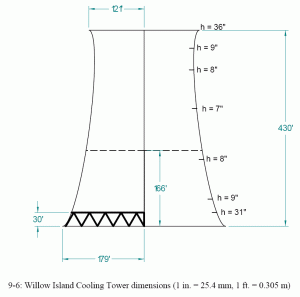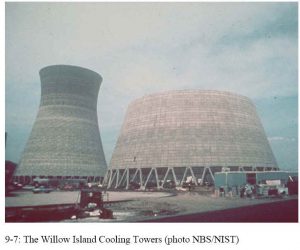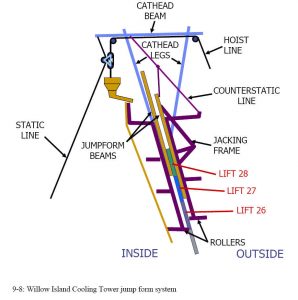Twenty-eight-day cylinder strength tells you how strong a concrete cylinder cured in a laboratory is at 28 days. It doesn’t necessarily tell you much about how strong the concrete in the structure is. The strength gain of concrete is highly dependent on ambient temperature. In cold weather, the concrete in a structure will be much weaker than laboratory cylinder strength would predict.
The Willow Island, West Virginia cooling tower collapsed while under construction on April 27, 1978, killed 51 workers in the worst construction disaster in U. S. history (Lew et al. 1979, Ross 1984, Kaminetzky 1991, Feld and Carper 1997). A jump form system was being used, with the forms secured by bolts in one-day and three-day-old concrete. The forms were designed to be progressively moved up the tower as it was built. The temperature had been in the mid-thirties at night. The National Bureau of Standards found that the concrete had not attained enough strength to support the forms. The report concluded that the most probable cause of the collapse was the imposition of construction loads on the shell before the concrete of lift 28 had gained adequate strength to support these loads (Lew et al. 1979).
References:
- Feld, J., and Carper, K. (1997). Construction Failure. 2nd Ed., John Wiley & Sons, New York, N. Y.
- Kaminetzky, D. (1991). Design and Construction Failures: Lessons from Forensic Investigations.
- McGraw-Hill, New York, N. Y.
Ross, S. (1984), Construction Disasters: Design Failures, Causes, and Prevention. McGraw-Hill, New York, N. Y. - Lew, H., Fattel, S., Shaver, J., Reinhold, T. and Hunt, B. (1979). Investigation of Construction Failure of Reinforced Concrete Cooling Tower at Willow Island, W.V., U.S. Department of Labor, OSHA/National Bureau of Standards, Washington, D.C.
Illustrations from Chapter 9 of the book Beyond Failure: Forensic Case Studies for Civil Engineers, Delatte, Norbert J., ASCE Press.









